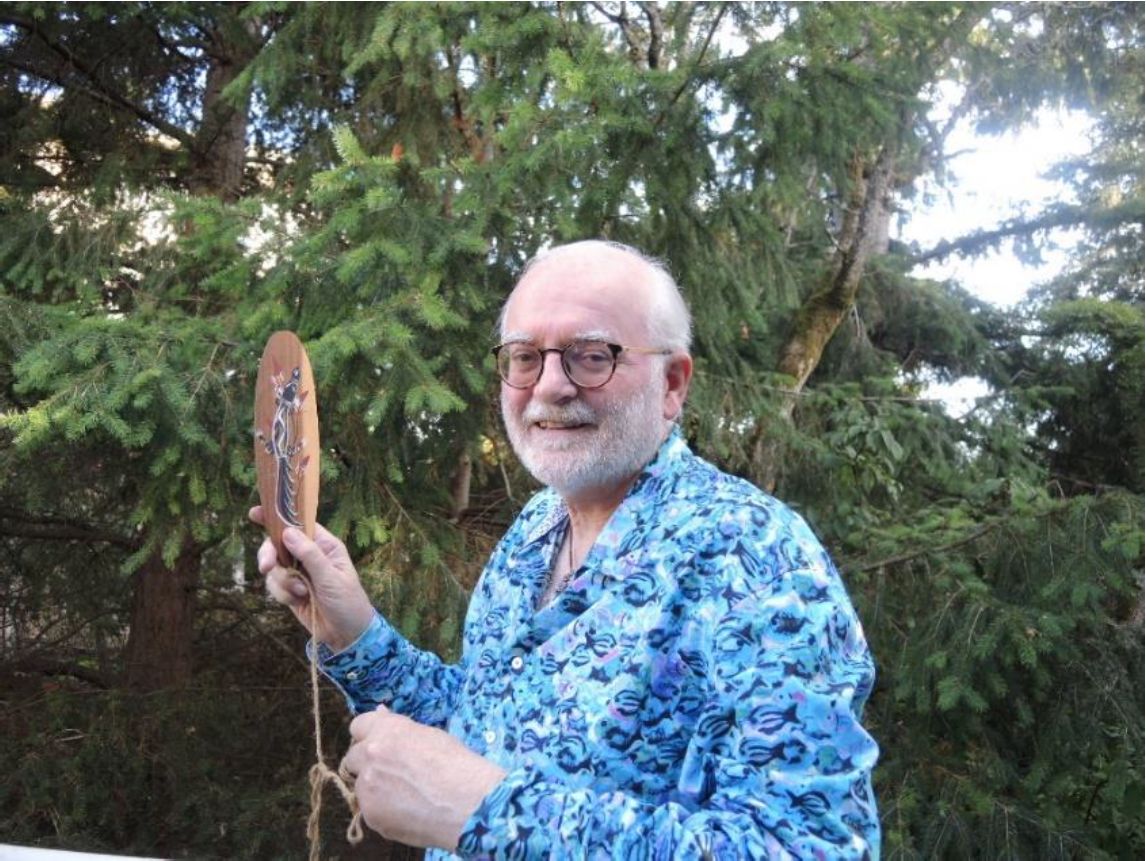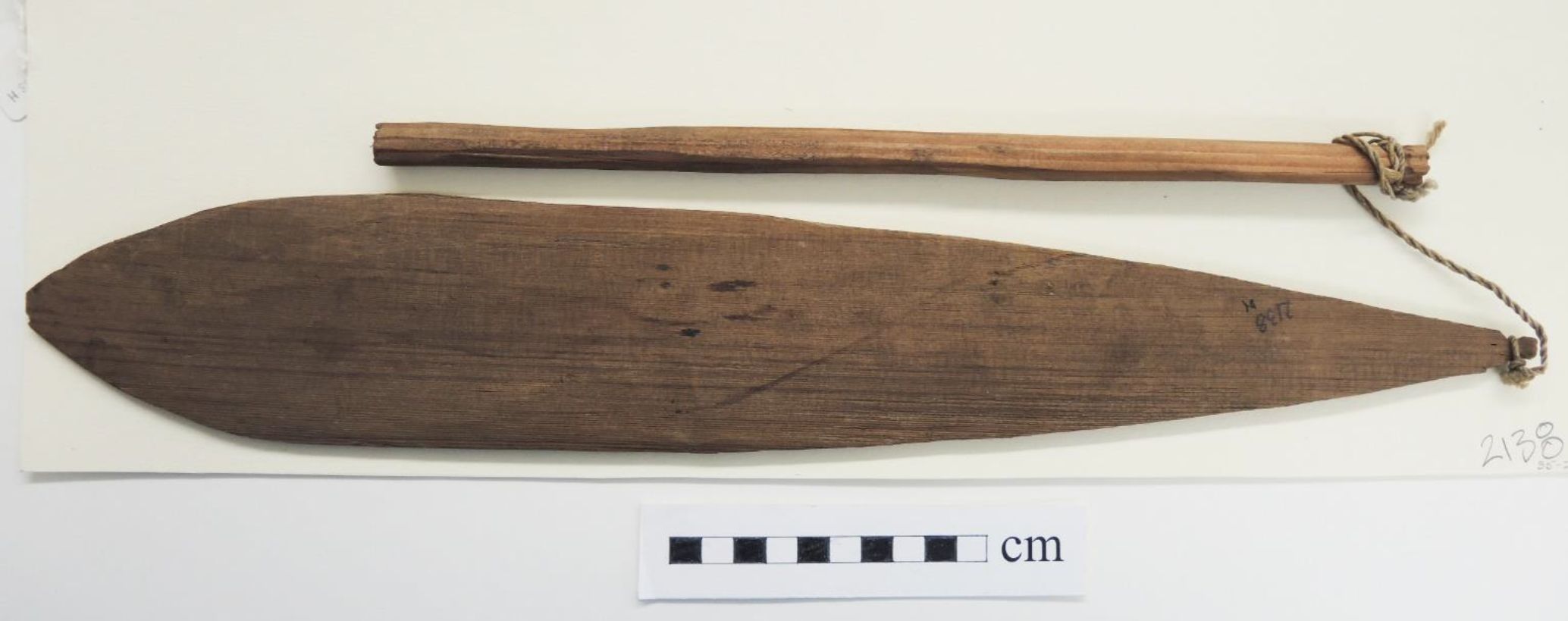By Grant Keddie. 2020.
Introduction
The bullroarer is an instrument used by many cultures around the world. It comes in many sizes and dates back at least 20,000 years in Europe. In some parts of my ancestral Scotland the bullroarer was known as a “Thunderspell” and in Aberdeen as a “Thunder-bolt”. It was used to protect people from being struck by lightning, but in one known case used by a farm boy to scare the cows home (Haddon 1898:222).
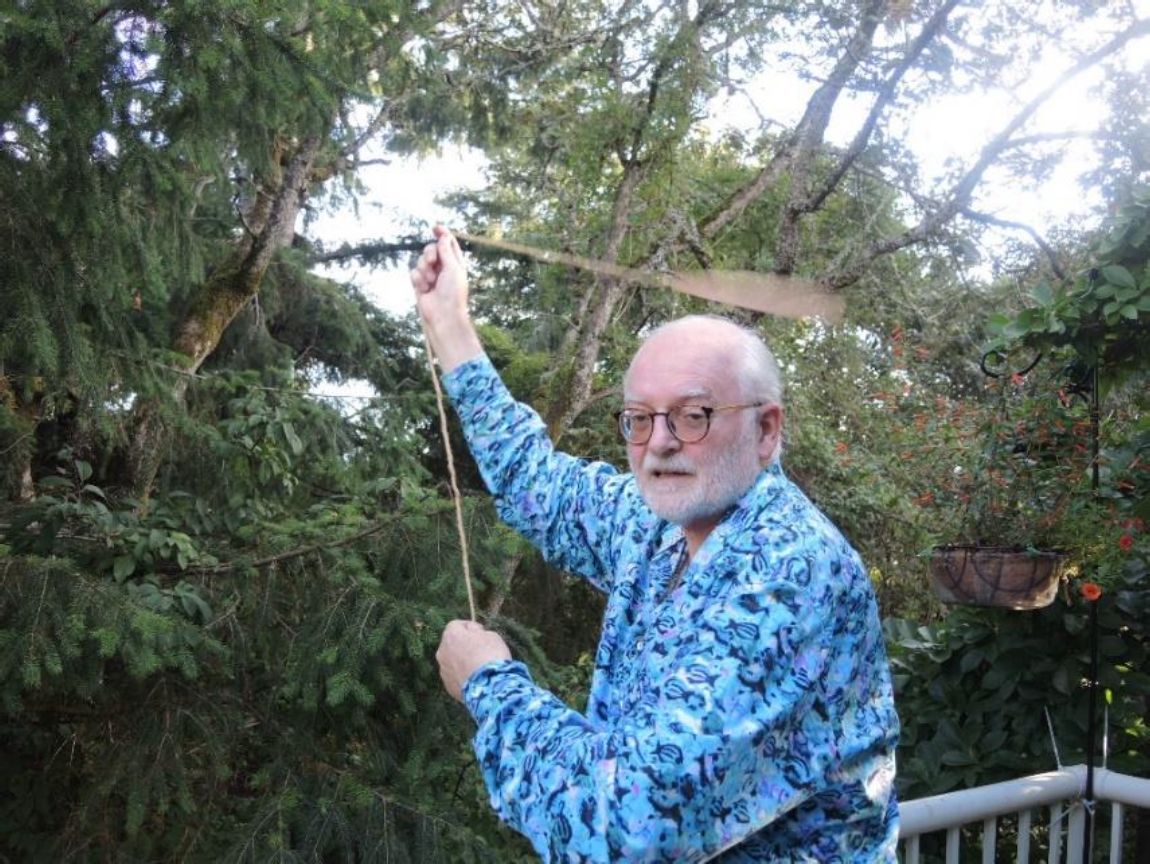
It is classed as an aerophone musical devise as it is spun in the open air, as opposed to an instrument that is blown into. It involves the use of a piece of flat wood, bone or other material tied to a cord that is twirled through the air to make a whirring or roaring sound. It is best known today as a devise popularized by the indigenous people of Australian who traditionally use it in religious ceremonies and to communicate with other tribes over long distances.
When I was a child I made bullroarers of various materials to see what kinds of noises they could make. I still have one that was made in Australia (figure 1&2). It is 250mm long, 70mm wide and tappers from a 2mm thick edge to 4mm at the centre – the latter thickness variation gives it a wind cutting edge with needed weight in the center.
The bullroarer was used as a toy among late 19th century Innuit children in a form similar to those of British Columbia but I suspect it may have been part of earlier adult rituals that were discontinued (Murdock 1892:379).
Bullroarers in the Collection
There are two similar bullroarers in the Indigenous ethnology collection of the RBCM purchased at “Nootka” on June 4, 1912, by Charles Newcombe. His catalogue entry is: “Cedar with handle and lanyard for dances”. They were both originally recorded with the number 2138, but one was later given the number 16921. The two are roughly the same size. Number 16921 is 485mm long, 75mm wide and 3mm thick at the edge with only slight variation toward the centre. Number 2138 is 480mm long by 77mm wide and 3mm on the edge.
Although the “dances” are not mentioned by Newcombe, a hint of their use might be given in the information provided by a pair of wooden Tsimshian bullroarers in the American Museum of Natural History (16_390BC) that were acquired between 1869 and 1890. They were referred to as “Thunderbird twirlers” and “used in dances to produce a sound like the rustling of bird’s wings”.

Another in the AMNH is a two bladed bull roarer (16/8125) with one blade half the size of the other. It was collected by anthropologist Franz Boas in 1900, from the Nimkish, Kwakwaka’wakw. Another Koskmo example from the Northwest coast of Vancouver Island is illustrated by Boas as what he called a “whirling stick” (1900, fig. 189).
Boas gives the best description of the use of the bullroarer as part of a complex winter dance ceremony among the Kwakwaka’wakw in which a novice is taken away to be initiated in the ha’mats’a secret society.
During the ceremony around midnight:
“a number of men secretly climb the roofs of the houses of the village and begin to whirl the whirling sticks. The noise of these sticks is supposed to be the voice of Hai’aLilaqas or Wina’lag.illis, who comes to take away another novice. This noise is repeated four times, each time for about ten minutes. Then the people sing their secret songs in the houses.” (Boas 1895:611).
Archaeological Bullroarers.
In the archaeology collection is what I suggest is a whalebone bullroarer. It is artifact DhRx-16:1166, from a large shellmidden at Departure Bay in Nanaimo (Figure 4 & 5). John Sendey rescued it from piles of bulldozed shellmidden. It is 206mm long by a maximum width of 42mm. It tappers up from the edge to a maximum thickness of 12mm. A hole for holding the cord is drilled mostly from one side.
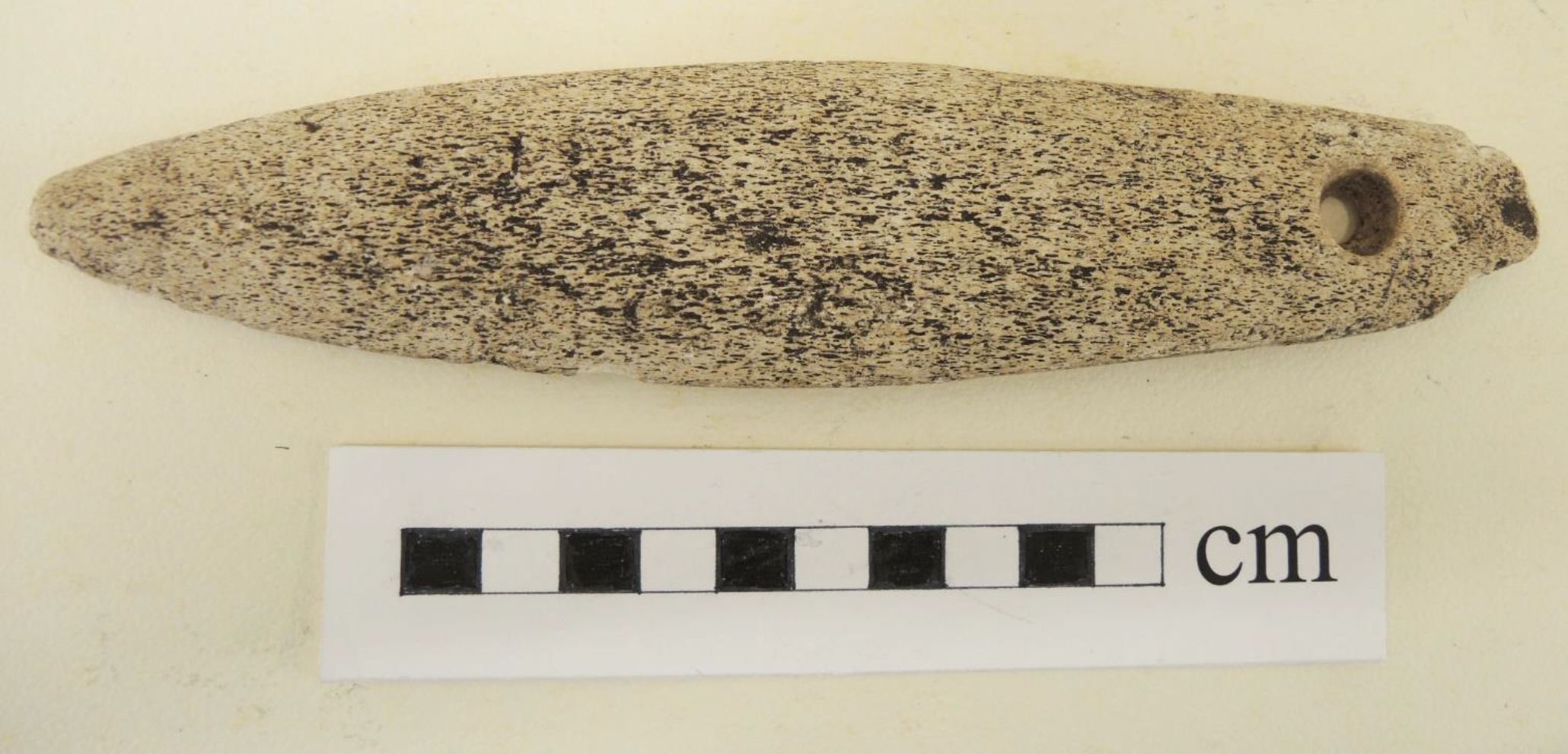
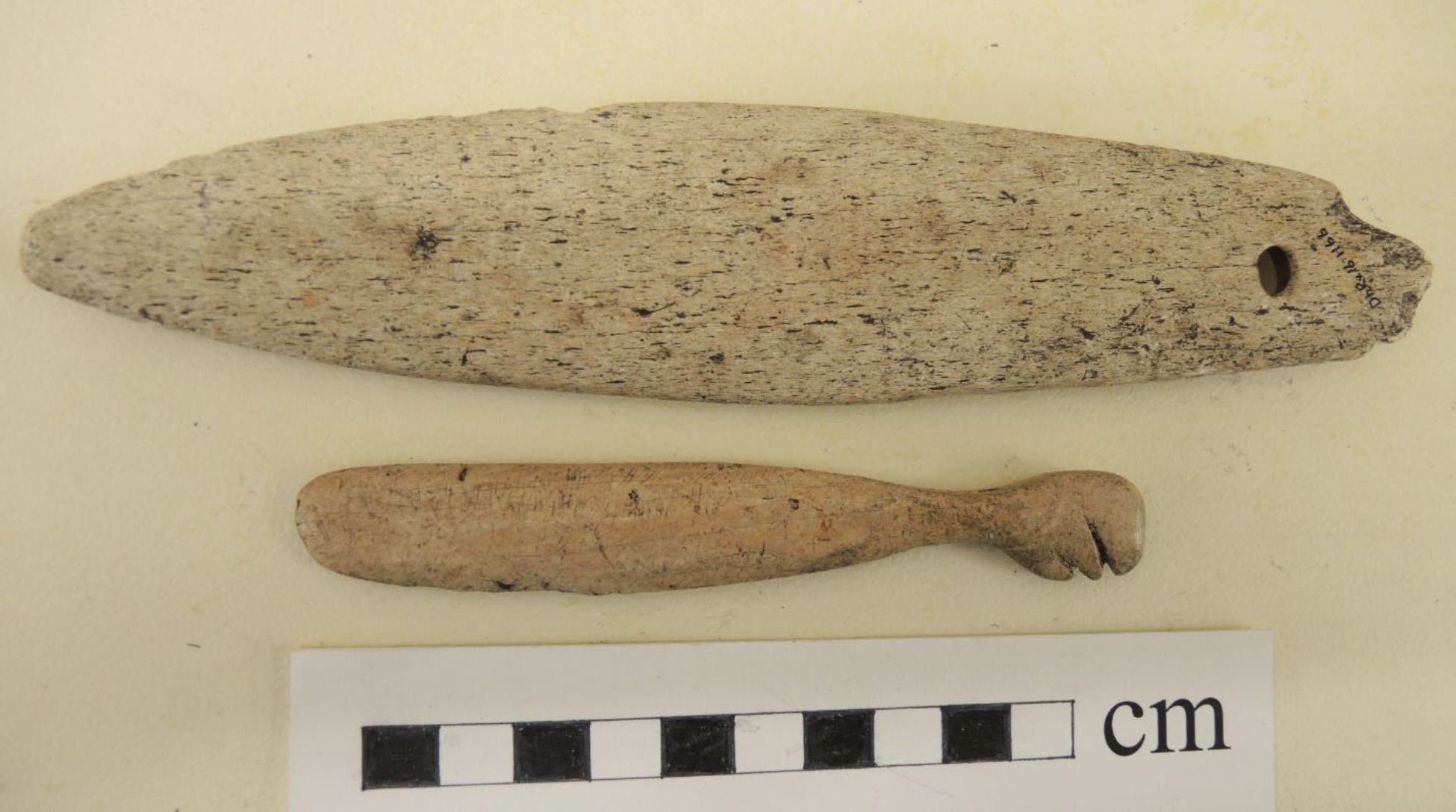
At first I thought this whale bone object was a toy club that may have had a broken proximal end with a carving like the well known larger clubs, but that does not appear to be the case. Unlike known clubs it has a hole drilled in the middle of its proximal end like many bullroarers. Although I cannot rule out that it was a small club that was broken and repurposed it is much smaller that the well known whale bone clubs and too big to be a toy. I have included a tiny club from our collection (figure 5), that is much smaller for comparison. This one could be either a toy or a decorative item like the small dangling paddles that are tied to historic dance outfits.
The tiny club is a unique artifact (DcRu-74:337) from a shellmidden site in Esquimalt Lagoon. It was found 65cm below surface but it shows manufacturing marks that are from an older style iron file. The markings are parallel but not evenly spaced as in commercially mass produced iron and steel files. This suggests that it is late pre-contact or early historic in age.
The only other archaeological artifact from British Columbia, suggested as a probable bullroarer is a bone one described by anthropologist Brian Hayden from the Keatley Creek site in the Interior Plateau (Hayden 2000:194; Fig. 3).
Conclusion
The ethnographic literature indicates that bullroarers are important indicators of social activities. They served a distinct social function associate with ritual activities in most societies where they were known. The positive identification of archaeological examples will be difficult, but there are likely more in existing collections that have not yet been identified.
References
Boas, Franz. 1895. The Social Organization and the Secret Societies of the Kwakiutl Indians. Report of the United States National Museum for the Year ending June 30. Washington.
Haddon, Alfred Cort. 1898. The Study of Man. Bliss, Sands & Co. London.
Hayden, Brian. 2000. Prestige Artifacts at Keatly Creek. In: The Ancient Past of Keatley Creek. Volume II: Socioeconomy. Edited by Brian Hayden, pp189- 202, Archaeology Press, Simon Fraser University, Burnaby B.C.
Murdock, John. Ethnological Results of the Point Barrow Expedition. Alaska 1881-1883. Ninth Annual Report of the Bureau of Ethnology. Washington Printing Office, 1892.
